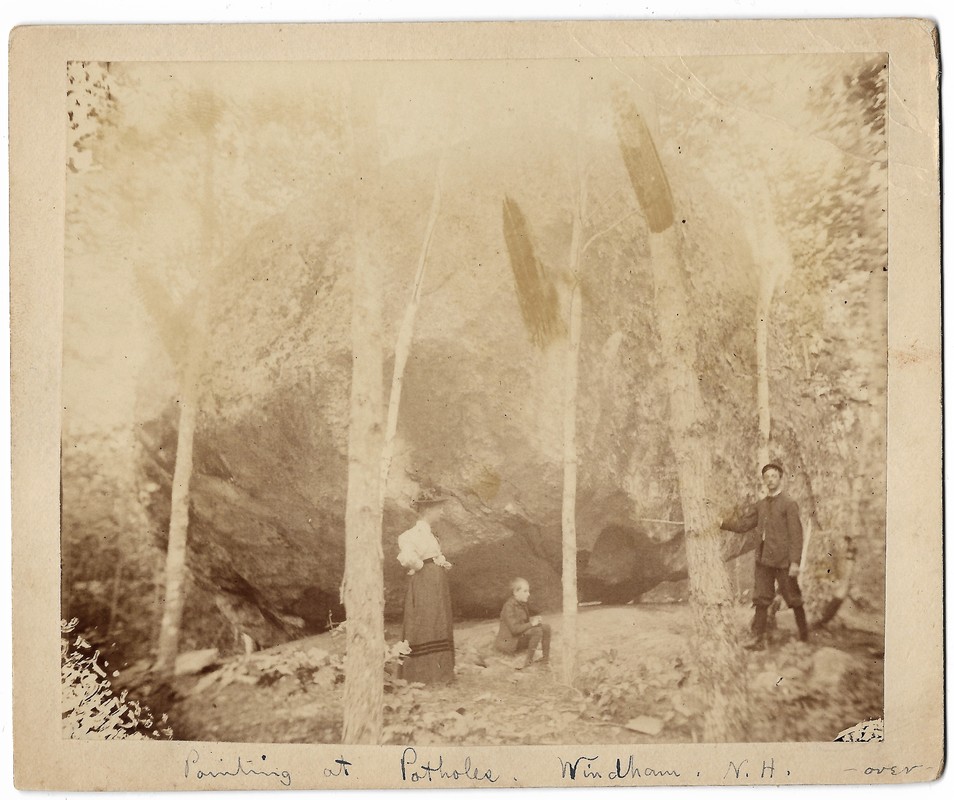Incidentally, according to Nutfield Rambles, Professor Edmund Angell of Derry was an inventor, chemist, photographer, and served as headmaster at Pinkerton Academy. Angell and his wife had two sons, Everett and Ralph; Everett was the eldest son. In March of 1890, young Everett became very ill, and a local doctor diagnosed the boy’s ailment as tonsillitis. Soon after the diagnosis, Everett passed away at the age of nine, and the family doctor noticed black spots on the boy’s arms, which indicated scarlet fever, and not tonsillitis. Ralph Everett was just five years old at the time of his brother’s passing. It is unknown if the Beekmans’ young companion for their trip to Butterfield’s Boulder was Everett or Ralph. As Professor Angell was a noted photographer in the area, it is possible he went along for the trip to Windham to photograph his son with Beekmans. Given his scientific background it is likely he would have had the interest to record a brief scientific description of the boulder, as well as notes on how the boulder was best photographer.
|
When W. S. Beekman, his wife, and a son of Professor Edmund Angell made the trip from Derry to Butterfield’s Boulder in Windham, they did so in search of a geological oddity that had fascinated so many other tourists and locals. In the late nineteenth century it would not have been uncommon for a . When the Beekmans and their young companion finished inspecting the glacial erratic, the photographer that accompanied them to take their photograph, possibly Professor Edmund Angell himself, positioned his camera on the ground in an attempt to show the underside of the boulder. According to the photographer’s notes, he wanted to show the ledge wall that appeared to him as though it was slanting upwards. However, he noted that “it is quite difficult to see when looking directly at rock.” As well as recording his brief physical observations, the photographer wrote a few lines as to the scientific nature of the boulder. He noted Butterfield’s Boulder is “granite with garnets” and measures approximately twenty feet by eighteen feet by fifteen feet.
Incidentally, according to Nutfield Rambles, Professor Edmund Angell of Derry was an inventor, chemist, photographer, and served as headmaster at Pinkerton Academy. Angell and his wife had two sons, Everett and Ralph; Everett was the eldest son. In March of 1890, young Everett became very ill, and a local doctor diagnosed the boy’s ailment as tonsillitis. Soon after the diagnosis, Everett passed away at the age of nine, and the family doctor noticed black spots on the boy’s arms, which indicated scarlet fever, and not tonsillitis. Ralph Everett was just five years old at the time of his brother’s passing. It is unknown if the Beekmans’ young companion for their trip to Butterfield’s Boulder was Everett or Ralph. As Professor Angell was a noted photographer in the area, it is possible he went along for the trip to Windham to photograph his son with Beekmans. Given his scientific background it is likely he would have had the interest to record a brief scientific description of the boulder, as well as notes on how the boulder was best photographer.
3 Comments
Jim Moore
6/14/2019 04:59:10 pm
VERY interesting. I have a postcard of this boulder. But to find the name of W S Beekman was a bonus! I have a collection of his Magic Lantern Slides, mostly from around eastern Massachusetts. They list him as residing in West Medford, MA.
Reply
Derek S.
6/15/2019 04:05:31 pm
Interesting! Any chance there are slides from the Windham area?
Reply
Jim Moore
11/8/2021 05:33:20 pm
Sorry, Derek. Mostly Massachusetts stuff. Leave a Reply. |
AuthorDerek Saffie is an avid Windham historian who enjoys researching and sharing his collection with all those interested in the history of the New England town. Archives
November 2019
Categories
All
|
